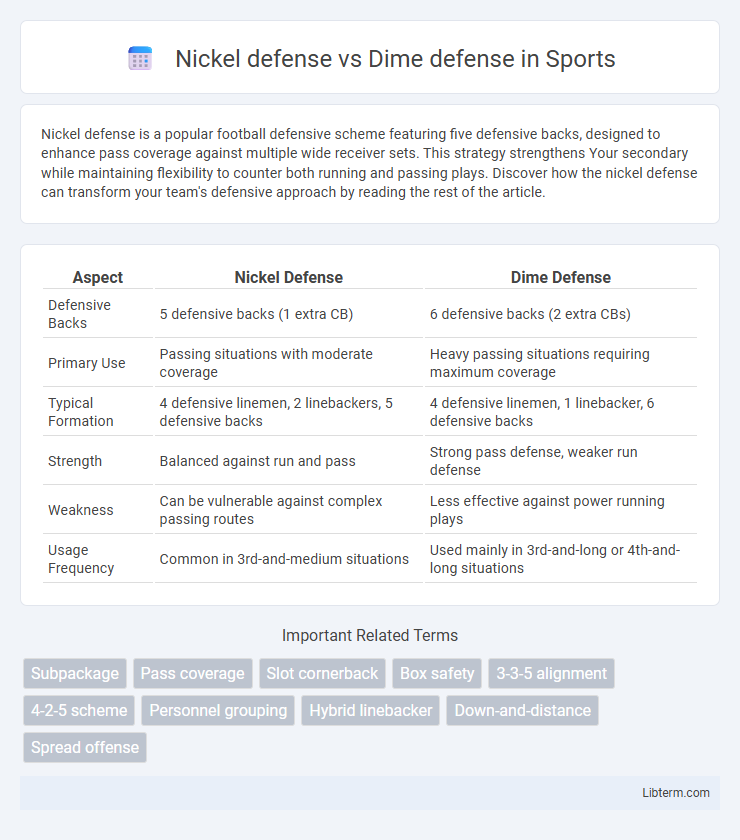Nickel defense is a popular football defensive scheme featuring five defensive backs, designed to enhance pass coverage against multiple wide receiver sets. This strategy strengthens Your secondary while maintaining flexibility to counter both running and passing plays. Discover how the nickel defense can transform your team's defensive approach by reading the rest of the article.
Table of Comparison
| Aspect | Nickel Defense | Dime Defense |
|---|---|---|
| Defensive Backs | 5 defensive backs (1 extra CB) | 6 defensive backs (2 extra CBs) |
| Primary Use | Passing situations with moderate coverage | Heavy passing situations requiring maximum coverage |
| Typical Formation | 4 defensive linemen, 2 linebackers, 5 defensive backs | 4 defensive linemen, 1 linebacker, 6 defensive backs |
| Strength | Balanced against run and pass | Strong pass defense, weaker run defense |
| Weakness | Can be vulnerable against complex passing routes | Less effective against power running plays |
| Usage Frequency | Common in 3rd-and-medium situations | Used mainly in 3rd-and-long or 4th-and-long situations |
Introduction to Nickel and Dime Defenses
Nickel defense employs five defensive backs including a nickelback, enhancing pass coverage against three-wide receiver sets while maintaining strong run support. Dime defense adds a sixth defensive back, the dimeback, optimizing coverage against four or more wide receivers and prioritizing defense against deep passing attacks. Both defensive schemes adapt personnel to counter multi-receiver formations, balancing coverage flexibility and run defense based on offensive alignment.
Core Concepts: What is a Nickel Defense?
A Nickel defense features five defensive backs, replacing a linebacker with an extra cornerback to better defend against passing plays. This alignment enhances pass coverage against three-receiver sets while maintaining sufficient run defense abilities. The core concept revolves around balancing speed and coverage to counter versatile offenses in modern football.
Core Concepts: What is a Dime Defense?
A Dime defense features six defensive backs, primarily used to counter passing offenses by adding extra coverage against multiple wide receivers. It employs four defensive linemen and one linebacker, enhancing pass defense but slightly reducing run-stopping ability. This formation emphasizes speed and coverage versatility, making it effective in long-yardage or obvious passing situations.
Personnel Differences in Nickel vs. Dime Packages
Nickel defense employs five defensive backs, typically four cornerbacks and one safety, replacing a linebacker to enhance pass coverage against three-receiver sets. Dime defense features six defensive backs, usually four cornerbacks and two safeties, substituting two linebackers to further strengthen pass defense against four or more wide receivers. The personnel shift from Nickel to Dime enhances defensive flexibility by increasing coverage speed and adaptability to complex passing formations.
Situational Use: When to Deploy Nickel or Dime
Nickel defense is primarily deployed against passing situations where offenses use three or four wide receivers, offering a balance between pass coverage and run support by adding a fifth defensive back. Dime defense is utilized in obvious passing downs or long-yardage scenarios, introducing a sixth defensive back to maximize coverage against multiple wide receiver sets and limit big passing plays. Choosing between Nickel and Dime depends on offensive personnel, down-and-distance, and game context to optimize defensive alignment and personnel matchups.
Strengths of the Nickel Defense
The Nickel defense excels in pass coverage by adding a fifth defensive back, enhancing the team's ability to defend against multiple wide receiver sets and complex passing attacks. This formation strengthens perimeter defense and improves speed and agility on the field, making it highly effective against short to intermediate routes. The Nickel defense also offers flexibility in blitz packages and coverage schemes, allowing linebackers to focus more on run support and quarterback pressure.
Strengths of the Dime Defense
The Dime defense excels in pass coverage by deploying six defensive backs, enhancing its ability to counter multiple wide receiver sets and complex passing routes effectively. This formation increases speed and agility on the field, allowing defenders to better cover short and intermediate zones, reducing the quarterback's options. Its strengths are particularly notable in obvious passing situations and long-yardage plays, where the emphasis on coverage over run defense limits big-play potential by the offense.
Weaknesses and Vulnerabilities Compared
Nickel defense, which uses five defensive backs, is vulnerable to power running plays due to fewer linebackers to control the run, making it less effective against strong inside runs. Dime defense, with six defensive backs, sacrifices linebacker presence even further, increasing susceptibility to short-yardage rushing attacks and inside runs. Both defenses excel against passing attacks but can struggle against teams that effectively mix runs and quick passes, exploiting the reduced linebacker support.
Impact on Pass and Run Defense
Nickel defense, featuring five defensive backs, enhances pass coverage by adding an extra cornerback or safety, improving defense against three-receiver sets while maintaining moderate run-stopping ability with four down linemen. Dime defense, incorporating six defensive backs, excels in pass defense by covering multiple wide receivers, significantly reducing passing lanes but weakening run defense due to fewer linebackers and linemen on the field. Both schemes balance pass and run defense differently, with Nickel favoring versatility in defending intermediate passing and run plays, and Dime prioritizing aggressive pass coverage at the expense of run-stopping strength.
Choosing the Right Defense: Strategic Considerations
Choosing between Nickel and Dime defenses hinges on the offensive formation and down-and-distance situations, with Nickel employing five defensive backs to balance pass coverage and run defense, while Dime utilizes six defensive backs for enhanced pass coverage in obvious passing scenarios. Strategic considerations include the opponent's passing tendencies, personnel matchups, and the need for speed versus physicality; Nickel is preferred against multiple wide receiver sets with potential running threats, whereas Dime excels in long-yardage situations demanding maximum pass defense. Effective defensive play-calling requires analyzing offensive personnel and situation-specific demands to optimize coverage, pressure, and run support balance.
Nickel defense Infographic

 libterm.com
libterm.com